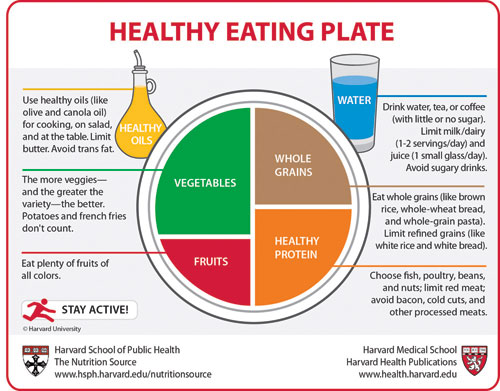Nutrition experts at the Harvard School of Public Health and colleagues at Harvard Health Publications recently served up a simple, colorful guide to healthy meal planning. Grounded in science, the Healthy Eating Plate highlights important deficiencies in the MyPlate chart developed by the U.S. government.

“Unfortunately, like the earlier U.S. Department of Agriculture pyramids, MyPlate mixes science with the influence of powerful agricultural interests, which is not the recipe for healthy eating,” said Walter Willett, Fredrick Stare Professor of Epidemiology and Nutrition, and chair of the Department of Nutrition at HSPH. “The Healthy Eating Plate is based on the best available scientific evidence and provides consumers with the information they need to make choices that can profoundly affect our health and well-being.” The Healthy Plate’s section sizes suggest relative proportions of each of the food groups. They do not prescribe numbers of calories or servings per day, since these vary from person to person. The plate is consistent with guidelines of a Healthy Eating Pyramid created at HSPH in 2001 and updated in 2008.
“One of the most important fields of medical science over the past 50 years is the research that shows just how powerfully our health is affected by what we eat,” said Anthony Komaroff, the Steven P. Simcox, Patrick A. Clifford and James H. Higby Professor of Medicine at Harvard Medical School and editor-in-chief at Harvard Health Publications, the consumer information division of HMS. “Knowing what foods to eat, and in what proportions, is crucial for health.”
Plates comparedComparing the Harvard Healthy Eating Plate to the USDA’s MyPlate reveals shortcomings in the latter. MyPlate does not tell consumers that whole grains are healthier than refined grains, for example. Nor does its protein section indicate that some high-protein foods—fish, poultry, beans, nuts—are healthier than red meats and processed meats.
MyPlate is silent on the subject of beneficial fats. It does not distinguish between potatoes and other vegetables. It recommends dairy at every meal—even though there is little evidence that high dairy intake protects people against osteoporosis, while substantial evidence suggests that high intake can be harmful. MyPlate says nothing about the downside of sugary drinks. Finally, MyPlate makes no mention of physical activity and weight control.
Obesity epidemicIn contrast, science underlying the Healthy Eating Plate shows that a plant-based diet rich in vegetables, whole grains, and healthy fats and proteins lowers the risk of both weight gain and chronic disease. Helping Americans get the best possible nutrition advice is critically important as the country grapples with an obesity epidemic. In the United States today, two in three adults and one in three children are overweight or obese.
“We want people to use this as a model for their own healthy plate or that of their children every time they sit down to a meal—either at home or at a restaurant,” said Eric Rimm, HSPH associate professor of epidemiology and nutrition, HMS associate professor of medicine and member of the 2010 U.S. Dietary Guidelines Advisory Committee.


